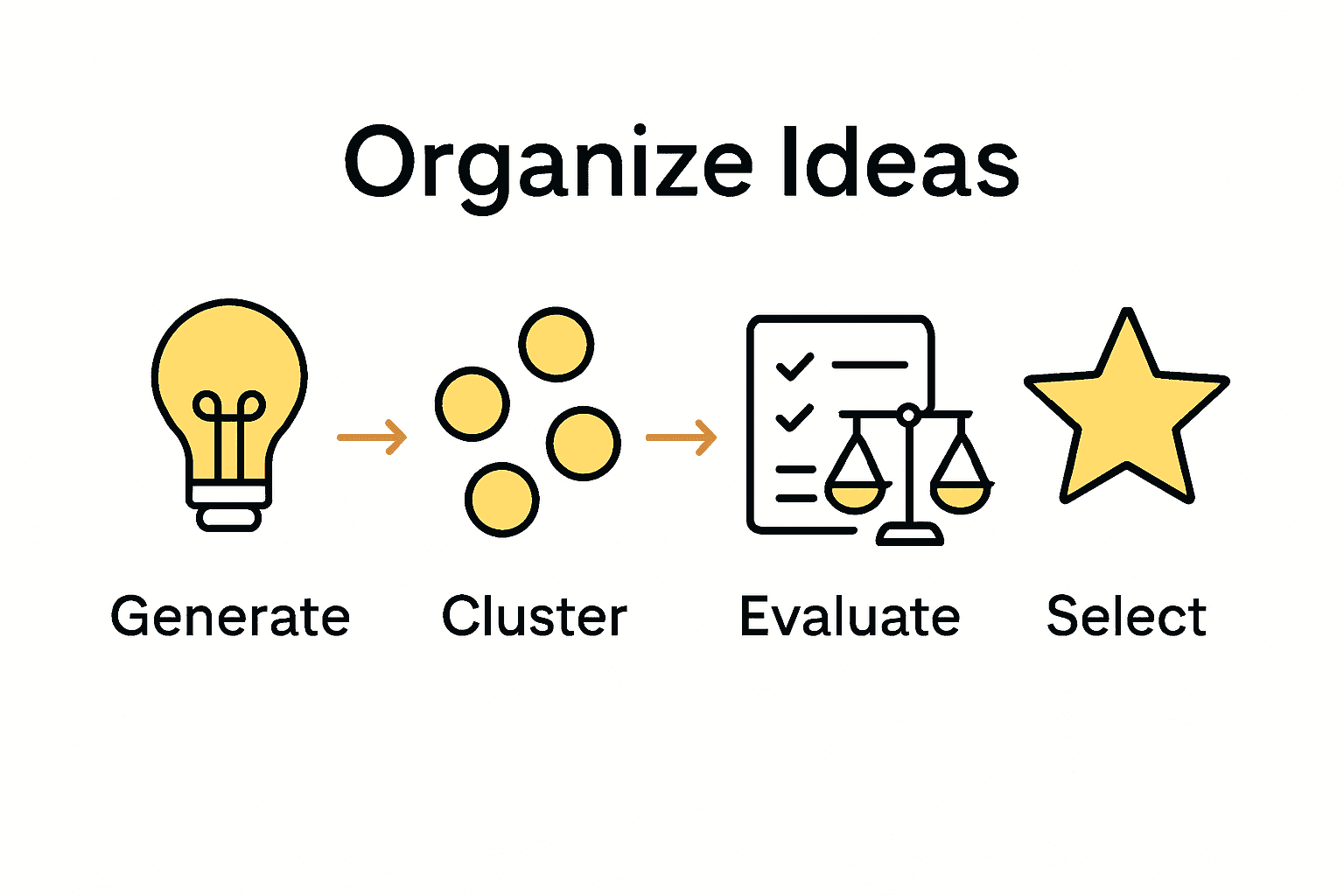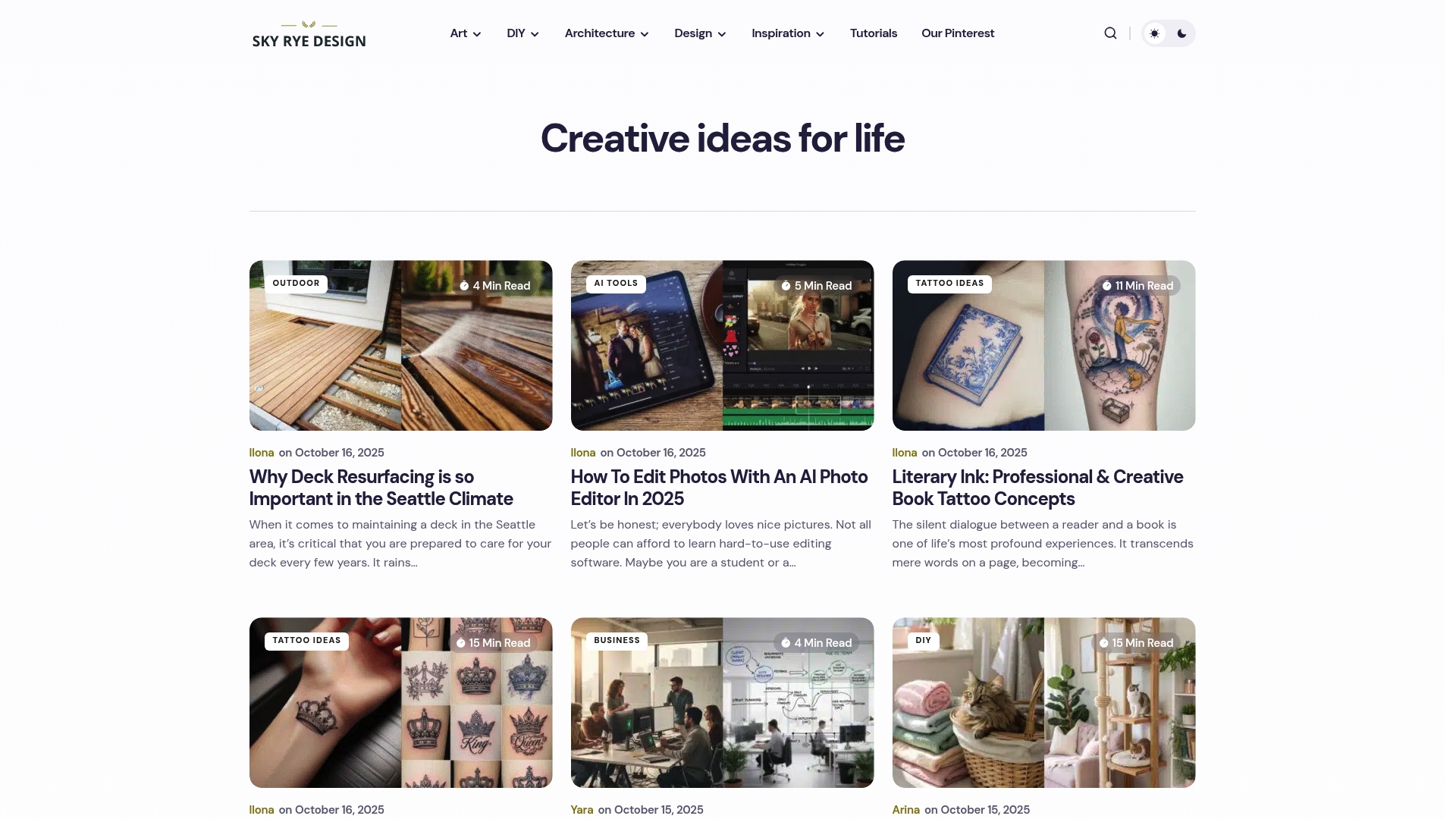Did you know that teams with a clear creative intention generate up to 40 percent more original ideas than those without one? Channeling creativity is not just about inspiration. It starts with a focused plan that turns chaotic thoughts into real results. By learning how to set strong intentions, gather the right inspirations, and guide brainstorming with purpose, you can set the stage for ideas that spark real change.

Quick Summary
| Key Point | Explanation |
|---|---|
| 1. Set a clear creative intention | Define a specific goal to direct your brainstorming efforts. This focus enhances idea generation and reduces confusion. |
| 2. Gather diverse inspirations and materials | Collect user research, visuals, and contextual information to fuel creativity. Diverse inputs enhance the relevance of your ideas. |
| 3. Facilitate structured idea generation | Use small groups and visual aids to encourage participation and creativity. Welcome all ideas to foster an open environment. |
| 4. Organize and refine ideas systematically | Cluster similar concepts and evaluate them based on feasibility and impact. This organizes thoughts for clearer action steps. |
| 5. Validate concepts with external feedback | Present ideas to stakeholders to gather constructive insights. This process strengthens concepts through diverse perspectives before implementation. |
Table of Contents
- Step 1: Set A Clear Creative Intention
- Step 2: Gather Relevant Inspirations And Materials
- Step 3: Facilitate Idea Generation Sessions
- Step 4: Organize And Refine Collected Ideas
- Step 5: Validate Concepts Through Feedback
- Step 6: Implement Chosen Ideas Effectively
Step 1: Set a Clear Creative Intention
Setting a clear creative intention transforms scattered thoughts into powerful, focused outcomes. Your first step in the brainstorming process involves creating a specific roadmap that guides your creative exploration.
Start by asking yourself a powerful question: What exactly do I want to achieve with this brainstorming session? According to research from creative strategy experts, establishing a single focused goal prevents mental overload and helps teams generate more impactful ideas.
To set your intention, grab a notebook and write down one precise objective. Maybe you want to design a breakthrough product concept. Or perhaps you aim to solve a specific challenge facing your team. The key is narrowing your focus. A vague goal like “generate some ideas” becomes a targeted mission like “develop three innovative solutions for reducing project turnaround time”.
Break down your intention into clear parameters. Consider questions like: What problem are we solving? What success looks like? What constraints or boundaries exist? These questions help frame your creative thinking and provide structure without limiting imagination.
Pro Tip: Treat your creative intention like a compass not a cage. It should guide you while leaving room for unexpected discoveries.
Once you establish your intention, you are primed and ready to unleash your team’s creative potential. Your next step will be gathering the right tools and creating an environment conducive to breakthrough thinking.
Step 2: Gather Relevant Inspirations and Materials
Now that you have a clear creative intention, it is time to collect the fuel that will power your brainstorming session. Gathering relevant inspirations and materials transforms your abstract goal into a tangible creative playground.
According to research from user experience experts, bringing in comprehensive user research grounds your brainstorming in real world context. Dive into demographics, user pain points, behavioral patterns, and competitor insights. These details are not just background information they are the secret sauce that makes your ideas genuinely relevant and user centered.
Start by creating a physical inspiration board. Grab colorful papers, markers, sticky notes, and visual prompts. Research shows that environmental stimuli can dramatically boost creativity. As experts from innovation consulting suggest, elements like themed rooms, background music, and even strategic snack placements can prime participants for more innovative thinking.
Consider creating different zones for your inspiration gathering. One area might showcase user research findings. Another could display competitor product images. A third zone could be dedicated to wild visual inspiration from unrelated industries. Mix textures, colors, and information to spark unexpected connections.

Pro Tip: Think of your inspiration gathering like cooking a complex meal. The more diverse and high quality your ingredients, the more exciting your creative dish will become.
With your inspiration materials assembled, you are now ready to move into the most exciting phase of brainstorming where imagination meets structured exploration. Your next step involves creating an environment that welcomes and amplifies creative thinking.
Step 3: Facilitate Idea Generation Sessions
With your inspiration materials ready and creative energy building, it is time to transform potential into powerful ideas. Facilitating an effective idea generation session requires strategic planning and a welcoming atmosphere that encourages fearless creativity.
According to research from design thinking experts, the most successful brainstorming environments follow key practices that unlock collective imagination. The golden rule is simple: defer judgment and welcome every idea. As experts from innovation consulting suggest, the goal is quantity over immediate quality.
Break your group into small subgroups of three to five participants. According to McKinsey research, smaller teams reduce the dominance of strong personalities and encourage broader input. Assign each subgroup a specific aspect of your creative challenge and set clear but generous time limits. This approach prevents analysis paralysis and keeps energy high.
Use visual aids to stimulate thinking. Whiteboards, sticky notes, sketching tools these are not just materials but portals to unexpected connections. Encourage participants to build on each other’s thoughts. One wild idea can spark a breakthrough concept when the group approaches suggestions with curiosity instead of criticism.
Pro Tip: Think of your brainstorming session like a jazz improvisation. The magic happens when everyone listens, responds, and plays off each other’s creative rhythms.
With ideas flowing and creativity unleashed, you are now prepared to move into the next crucial phase: capturing and evaluating the most promising concepts that emerged during your generative session.
Step 4: Organize and Refine Collected Ideas
Congratulations. Your idea generation session has unleashed a torrent of creativity. Now comes the critical phase of transforming raw inspiration into actionable strategies.
According to research from project management experts, the key is systematic organization. Start by clustering similar ideas into thematic groups. Think of this process like sorting colorful puzzle pieces into meaningful sections. Digital collaboration tools like Miro or Trello can help tremendously in this process, allowing teams to visually map connections between concepts.

Evaluate each idea cluster through two primary lenses: feasibility and potential impact. Ask your team pointed questions. Which ideas solve the core challenge most effectively? What resources would each concept require? Which solutions align most closely with your original creative intention?
Research from tech innovation teams suggests using techniques like affinity diagrams to sort and structure ideas. This method helps create clarity and supports smoother transitions from brainstorming to implementation. Create a voting process where team members can collectively identify the most promising concepts. This approach reduces individual bias and builds collective ownership.
Pro Tip: Treat idea refinement like a sculptor approaches marble. Your goal is not just selection but revealing the most elegant potential within your raw creative material.
Once you have identified top ideas, transform them into concrete action steps. Break down each promising concept into specific goals using the SMART framework specific, measurable, achievable, relevant, and time bound.

Step 5: Validate Concepts Through Feedback
You have crafted promising ideas through careful brainstorming. Now comes the critical moment of external validation where your concepts will be tested against real world perspectives and potential challenges.
According to research from organizational development experts, narrowing your ideas to the top two or three options sets the stage for strategic validation. When presenting to decision makers or stakeholders, approach the conversation with structured preparation. Your goal is to demonstrate not just creativity but practical potential.
Prepare a clear presentation that addresses key evaluation criteria. According to expert recommendations, focus on answering critical questions like: What specific problem does this solution solve? What resources are required? What potential challenges might emerge? How does this concept align with broader organizational goals?
Seek feedback from diverse perspectives. Include team members with different backgrounds and expertise. Someone from finance might spot economic considerations. A technical expert could highlight implementation challenges. A customer service representative might provide insights about user experience.
Pro Tip: Think of feedback like a friendly sparring match. The goal is not to defend your idea but to strengthen it through collaborative refinement.
Remember that feedback is not about winning or losing. It is about transforming good ideas into great solutions. Be open to constructive criticism. Each perspective offers an opportunity to polish and improve your creative concept before moving toward implementation.
Step 6: Implement Chosen Ideas Effectively
The moment of truth has arrived. Your creative journey transforms from imagination to real world action. Implementation is where brilliant concepts become tangible results.
According to research from project management experts, successful implementation requires turning abstract ideas into concrete actionable steps. Start by developing a comprehensive project roadmap that breaks down your chosen concept into clear milestones and deliverables.
Create a strategic implementation plan using the SMART framework. This means setting goals that are Specific, Measurable, Achievable, Relevant, and Time bound. Assign clear roles and responsibilities to team members. Who will own each aspect of the project? What are their specific accountabilities? Clarity prevents confusion and ensures smooth execution.
Establish regular check in points to monitor progress and remain adaptable. Implementation is not a linear process but a dynamic journey. Be prepared to adjust your approach based on real world feedback and emerging challenges. Think of your plan like a living document that evolves with your project.
Pro Tip: Treat implementation like navigating a complex journey. Have a map but be ready to take unexpected detours when opportunities or challenges arise.
Document your progress meticulously. Track not just outcomes but learning experiences. Each challenge overcome becomes valuable knowledge for future creative endeavors. Your implementation is not just about completing a project but building organizational creativity and resilience.
Here’s a summary of each creative brainstorming step:
| Step | Main Action | Key Tools/Approaches | Pro Tips |
|---|---|---|---|
| Set Intention | Define a clear goal | Notebook Clarifying questions | Use intention as a compass |
| Gather Inspirations | Collect research and visuals | Research boards Visual prompts | Diverse “ingredients” boost creativity |
| Facilitate Ideas | Run structured brainstorming | Subgroups Whiteboards Sticky notes | Defer judgment, encourage play |
| Organize Ideas | Cluster and refine ideas | Digital tools Affinity diagrams Voting | Sculpt ideas to reveal best options |
| Validate Concepts | Present and get feedback | Presentations Stakeholder input | Seek diverse, constructive feedback |
| Implement Ideas | Plan, assign, and execute | Roadmaps SMART goals Check-ins | Stay adaptable, document lessons |
Unlock Your Most Inspired Ideas with Skyrye Design
If you have ever struggled to transform scattered thoughts into creative results, you are not alone. The article showed how the right creative brainstorming process can help you set clear intentions, organize ideas, and push your imagination beyond its limits. Many creators face the frustration of mental overload or lose momentum when ideas fail to connect with real needs. But you do not have to face these pain points alone. Imagine moving from vague inspiration to breakthrough concepts that truly spark change.

Discover practical steps, real-world examples, and a community passionate about creativity at Skyrye Design. Whether you need step-by-step guides for design thinking, actionable inspiration for your home or personal projects, or actionable art tutorials, you will find expert tips right at your fingertips. Now is your chance to take action. Start today by exploring our collection of creativity resources. Let Skyrye Design help you achieve meaningful breakthroughs and bring your next vision to life. Visit Skyrye Design and unlock your true creative potential.
Frequently Asked Questions
How do I set a clear creative intention for brainstorming?
Start by defining a specific goal for your brainstorming session, like solving a particular challenge or generating innovative solutions. Write down your objective, such as “develop three new product ideas,” to guide your creative process.
What materials should I gather for an effective brainstorming session?
Collect relevant user research, competitor insights, and visual inspirations to create a rich pool of ideas. Create an inspiration board with diverse materials to enhance creativity and encourage innovative connections among team members.
How can I facilitate an idea generation session?
Break your team into small subgroups, assign each a specific part of the challenge, and encourage a free flow of ideas without judgment. Use visual aids like whiteboards and sticky notes to document thoughts and foster collaboration among participants.
What steps should I take to organize and refine collected ideas?
Cluster similar ideas into thematic groups and evaluate them based on feasibility and potential impact. Use voting methods to identify the most promising concepts, helping your team focus on ideas that align with your original intention.
How can I effectively validate concepts after brainstorming?
Narrow your ideas down to the top two or three and present them to stakeholders clearly, addressing their potential challenges and required resources. Seek feedback from a diverse group to strengthen your concepts before implementation.
What is the best approach to implement chosen ideas?
Develop a detailed project roadmap with specific milestones and roles for team members, ensuring each aspect of the project is clearly assigned. Regularly check in on progress and be ready to adapt your plan as needed to meet project goals.
Recommended
- Drawing inspiration | Sky Rye Design
- journal | Sky Rye Design
- Winning Pitch Deck | Sky Rye Design
- projects | Sky Rye Design
Article generated by BabyLoveGrowth
- 3shares
- Facebook0
- Pinterest3
- Twitter0


